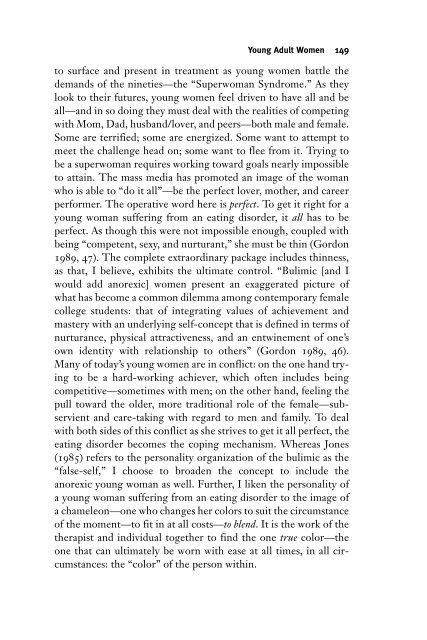Eating Disorders - fieldi
Eating Disorders - fieldi
Eating Disorders - fieldi
Create successful ePaper yourself
Turn your PDF publications into a flip-book with our unique Google optimized e-Paper software.
Young Adult Women 149<br />
to surface and present in treatment as young women battle the<br />
demands of the nineties—the “Superwoman Syndrome.” As they<br />
look to their futures, young women feel driven to have all and be<br />
all—and in so doing they must deal with the realities of competing<br />
with Mom, Dad, husband/lover, and peers—both male and female.<br />
Some are terrified; some are energized. Some want to attempt to<br />
meet the challenge head on; some want to flee from it. Trying to<br />
be a superwoman requires working toward goals nearly impossible<br />
to attain. The mass media has promoted an image of the woman<br />
who is able to “do it all”—be the perfect lover, mother, and career<br />
performer. The operative word here is perfect. To get it right for a<br />
young woman suffering from an eating disorder, it all has to be<br />
perfect. As though this were not impossible enough, coupled with<br />
being “competent, sexy, and nurturant,” she must be thin (Gordon<br />
1989, 47). The complete extraordinary package includes thinness,<br />
as that, I believe, exhibits the ultimate control. “Bulimic [and I<br />
would add anorexic] women present an exaggerated picture of<br />
what has become a common dilemma among contemporary female<br />
college students: that of integrating values of achievement and<br />
mastery with an underlying self-concept that is defined in terms of<br />
nurturance, physical attractiveness, and an entwinement of one’s<br />
own identity with relationship to others” (Gordon 1989, 46).<br />
Many of today’s young women are in conflict: on the one hand trying<br />
to be a hard-working achiever, which often includes being<br />
competitive—sometimes with men; on the other hand, feeling the<br />
pull toward the older, more traditional role of the female—subservient<br />
and care-taking with regard to men and family. To deal<br />
with both sides of this conflict as she strives to get it all perfect, the<br />
eating disorder becomes the coping mechanism. Whereas Jones<br />
(1985) refers to the personality organization of the bulimic as the<br />
“false-self,” I choose to broaden the concept to include the<br />
anorexic young woman as well. Further, I liken the personality of<br />
a young woman suffering from an eating disorder to the image of<br />
a chameleon—one who changes her colors to suit the circumstance<br />
of the moment—to fit in at all costs—to blend. It is the work of the<br />
therapist and individual together to find the one true color—the<br />
one that can ultimately be worn with ease at all times, in all circumstances:<br />
the “color” of the person within.









